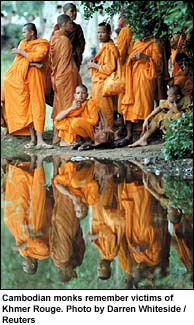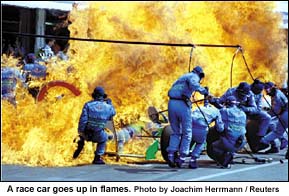|
"The
Art of Seeing" The turn of the millenium was a time for a retrospective of photo journalism and put a heavy load of books a on my bookshelf. Among the best was the also must voluminous tome — Phaidon’s "Century" - conceived and edited by Bruce Bernard, who sadly died shortly after the book’s publication. With a weight of about six pounds and 1120 pages thick the book was sold with a handle to be carried from the book stores. There were photo books about the Russian Century, the American Century, the Chinese Century, the Century of Britain and many others, equally weighty — and all best sellers. The venerable London-based Hulton —Deutsch Library, now called the Hulton Getty Picture Collection Ltd after being absorbed by the Getty organization, knocked a whole series of low-cost, rather haphazardly edited tri-lingual photo-books together, drawing from their vast treasures of late 19th and 20th century news photography. Hal Buell ‘s book "Moments, a Visual Chronicle of Our Time" with all Pulitzer Prize-winning photographs , published in 1999, combines the press photography which received the highest recognition since the Pulitzer Prize for photography was established in 1942. His anthology, just as the very similar catalogue and exhibition "The Pulitzer Prize Photographs — Capture the Moment" initiated and edited by Cyma Rubin in co-operation with Eric Newton of the Newseum, have been a continuing sales success. The Associated Press celebrated its 150 year of passage from the days of the pony express to digital and satellite delivered photography with "Flash — The Associated Press Covers the World." The AP’s photographic service was initiated in 1927. The book still sells well. While some pundits in the business of news photos augur the demise of press photography as we know it, business with the past achievements from the odd hundred fifty years of photo journalism seems brisk.
And now we can add a coffee table book presenting the "best of Reuters photography" — "The Art of Seeing", put together and edited by Reuters’ 41-year old former world photo editor and now the organization’s Marketing Director, Pictures, Ulli Michel, a German. Ulli Michel may not have known that "The Art of Seeing" is a much reprinted book by Aldous Huxley from 1942, in which Huxley tells his personal story of recovering his vision. But then book titles are, I am told, not copyrighted. Although a mere teenager among the venerable, long established photo agencies — the Reuters Picture Service commenced in 1985 — Reuters has maintained a competitive position among the top three international news photo agencies, AP, Reuters and Agence France Press (AFP) since the agency went back into the photo business. United Press International Photos and Reuters. It is a disappointment that the text does not even mention the other, once highly respected parent of the Reuters Photo Service — United Press International. Although owners and managers at UPI headquarters in New York and later in Washington struggled for years against each other and simultaneously to keep the company afloat, often out of cash and many times on the brink of financial collapse, Unipressers (as UPI staffers were called) in the field were good soldiers and a rough and tough international competition for The AP, right up to the last days of the company’s existence. The former UPI editors Gregory Gorden and Ronald E.Cohen wrote later, "for decades its (UPI’s) employees had been underpaid, uncomplaining foot soldiers of the news industry, working anonymously in cramped bureaus with old and creaky equipment … By sheer hard work and ingenuity they often beat their giant rival on major stories. To Unipressers their company always had been more than a business. It was an institution, a crusade." While this writer served in Vietnam, United Press International Photos was the only serious competition to AP in covering the war. We respected each other and the picture play reports coming in from New York and London were like the results of a never ending tennis match. We celebrated together when one or the other agency won a Pulitzer for Photos — and at the end of the war the score was even: 3:3. 1965 — Horst Faas (AP) 1966 — Kyoishi Sawada (UPI) 1968 — Toshio Sakai (UPI) 1969 — Eddie Adams (AP) 1972 — David Hume Kennerly (UPI) 1973 — Nick Ut (AP). Reuters has yet to win a Pulitzer for Photography. Ulli Michel informs that Reuters today employ 130 fulltime staff photographers, and many more contract and freelance photographers. Their generally aggressive coverage from the troublespots and frontlines of theworld came with the cost of talents lost forever: In the fifteen year period, four Reuters photographers have paid the price of their lives. Hos Maina and Dan Eldon were killed by a mob in Mogadishu, along with AP's photographer Hansi Kraus. Robert Navas was caught in an exchange of gunfire during the El Salvador civil war. Willie Vicoy, a (United Press International) war legend from Vietnam was killed in an ambush by rebels in the Phillipine Islands. If one considers ACME Newspictures photo agency as the parent of UPI Photos, UPI Photos were even older than AP Photos. ACME Newspictures had been set up in 1925 by Scripps, then sold to United Press in January 1952. In 1954 the UP Photo Service joined forces with Hearst’s International News Service (INS) to compete with the mighty AP, and UP became UPI.
In 1985 Reuters entered the news picture business. The hardcore of the new photo organization’s staff were capable and toughened Unipressers, enthusiastic and ready to rejoin the fight for dominance of the international picture market against the AP. Charlie McCarty, then already a hardened UPI veteran, lead his bloodied troops into a land of plenty: More pay, more investments in better equipment and communications and an orderly management, something new for the Unipressers who lived in chaos for decades. The year of 1985 was a time of great optimism in the news photo business, the best men from UPI Photos kept their jobs, and privately many at AP were quite pleased that the old competitive challenge would be preserved, leaving no chance for cost cutting staff reductions or limitation in coverage at the AP, in absence of competition. It was last-not-least thanks to the Unipressers that the Reuters Photo Service started off with a flying start. Fifteen years later the rumour mill of Fleet Street had it that Reuters Management were not fully satisfied with the bottom line of their photo service, which has undergone many restructures to cut costs and red tape. However, at the book launch of "The Art of Seeing" it was made clear that the book’s publication should be seen as a statement of trust in the future of the Reuters photo service. 1944-1965, Reuters first venture as a photo company It would not have been the first time Reuters had added photos to their news services portfolio only to get out of the photo business again. In 1944 the American news agencies, especially AP, had developed a photo service as a useful adjunct to their international news contracts and Reuters thought it might be useful to enter the news photo field. Reuters and the Press Association (of Britain) joined forces to set up a new company, which was generally referred to as "the photo company’. But in the early sixties photos had become almost exclusively a concern of the Press Association and the initial hope that with Reuters participating the ‘photo company’ would become an international picture agency was never realised. By 1965 Reuters dropped out all-together and the ‘photo company’ became a department of the Press Association. Soon after, PA joined forces with AP, a photo marriage that lasts until this day. The Stories of Reuters Photographers The best in "The Art of Seeing" are the accounts of Reuters’ photographers about the conditions of their assignments and how they managed to take their photographs. Like in Hal Buell’s and Cyma Rubin’s books on the Pulitzers, each photograph in the Reuters book is accompanied by an account from the photographer. Careful preparations and - often very modestly admitted - a lot of luck were involved to take the right photograph. Browsing through the book
The book looks like a wire service report, hard news pictures follow artful features, sports, the silly photos right next to a tragic scene that will be remembered for a long time, all mixed together. It would be quite right for the news photo wire to move a picture of a smug Monica Lewinsky followed by a photograph of the Queenmother holding a cross during a remembrance service. Or if a touching photo of the Pope follows the transmission of an image of Princess Diana posing with a child. But seeing these photos side by side in this book is another matter. The book does not flow, has no rhyme or reason — except the expressed purpose to show off good news photos which one by one gave the AP more or less grief, because they were simply better. During a Stammtisch (a regular get-together over drinks) of young and old photographers and photo editors in a Munich beer hall this week the book made the rounds. Many photos were remembered because they made it into the local papers. Manfred Zettler, former photo editor at a major newspaper in East Germany (after reunification) and editor at the Munich Abendzeitung - both dailies are Reuters photo subscribers - said: "Reuters Photos were always important to us - and that alone justifies to publish the photographers best picture again in book form. Unfortunately the book has become only a book of good pictures - and browsing through it, I think the editing was a bit uncaring. A chronological sequence and a more caring layout would have done wonder. However, I like to express my compliments to the Reuters photographers who seem always keen to improve the routine press photo." Bruno Arnold, formerly photographer for major German magazines who writes for photo magazines today, thinks similarly: "The book lacks a clear direction. Excellent photographs are not presented to their best advantage and confronted with others without consideration of their graphic value and their content. The design does not profile the often excellent texts of the photographers well enough, as they should to put more emphasis on the photographs. Good journalism has been presented very un-journalistically." It is a book to show off good wire service photos. What the photographers saw has been skillfully documented. But art it isn’t. Copyright: Horst Faas "The Art of Seeing —the best of Reuters photography" by Ulli Michel was published by Pearsons Education, worldwide. First published in Britain, August 2000. All Photos and quotes from the book copyrighted by Reuters 2000. ISBN 0 273 65011 4
|
|||
 "The
Art of Seeing" — Reuters Photography
"The
Art of Seeing" — Reuters Photography The
dismemberment of UPI photos began when UPI’s historic photo
library of 11 million photo negatives was sold in a joint venture
to the Bettmann Archives in a deal the then UPI newsphoto editor
Ted Majewski called "stupid" In 1984 the then owners of
UPI began to negotiate the sale of one of UPI’s most prized
parts, the award winning newspicture service, to Reuters. There
were shouts of "goddamned rape", when it became known
that UPI’s owners were ready to turn over the agency’s
foreign photo staff and all overseas picture contracts to Reuters,
while providing Reuters with pictures of American news events. A
clause permitting Reuters to independently market their own pictures
in the United States to the big papers served to eventually knock
UPI out of the photo business all-together. The deal was announced
in June 1984 and UPI had been emasculated.
The
dismemberment of UPI photos began when UPI’s historic photo
library of 11 million photo negatives was sold in a joint venture
to the Bettmann Archives in a deal the then UPI newsphoto editor
Ted Majewski called "stupid" In 1984 the then owners of
UPI began to negotiate the sale of one of UPI’s most prized
parts, the award winning newspicture service, to Reuters. There
were shouts of "goddamned rape", when it became known
that UPI’s owners were ready to turn over the agency’s
foreign photo staff and all overseas picture contracts to Reuters,
while providing Reuters with pictures of American news events. A
clause permitting Reuters to independently market their own pictures
in the United States to the big papers served to eventually knock
UPI out of the photo business all-together. The deal was announced
in June 1984 and UPI had been emasculated. The
Reuters photo service was borne into a time when black and white
photography was phased out and digital photography began. With few
exceptions more recent pictures are all electronic, and all are
in colour — the mix of old black and white and recent colour
does not necessarily work well in the layout of the book. In other
books black and white gradually turns to colour and the years progress.
The
Reuters photo service was borne into a time when black and white
photography was phased out and digital photography began. With few
exceptions more recent pictures are all electronic, and all are
in colour — the mix of old black and white and recent colour
does not necessarily work well in the layout of the book. In other
books black and white gradually turns to colour and the years progress.